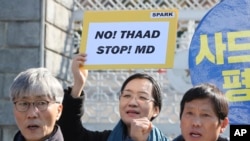The U.S. deployed the first elements of its Terminal High Altitude Area Defense (THAAD) missile defense system to South Korea Tuesday, one day after North Korea launched at least four ballistic missiles, three of which landed within 350 km of the Japanese mainland.
Last year, Washington and Seoul agreed to expedite the U.S. missile shield deployment in the face of North Korea’s accelerated testing and development of its nuclear and ballistic missile programs.
"Continued provocative actions by North Korea, to include yesterday’s launch of multiple missiles, only confirm the prudence of our alliance decision last year to deploy THAAD to South Korea,” Admiral Harry Harris, the commander of U.S. Pacific Command said in a statement.
Harris said the THAAD elements were deployed to honor alliance commitments to South Korea and to help defend U.S. troops in the region, U.S. allies and the American homeland.
The THAAD system could be operational as early as April, according the South Korean military.
Like the Patriot missile system, THAAD uses missiles to shoot down incoming missiles. THAAD is a battery of 48 missiles on mobile erector launchers that uses powerful radar and infrared technology to intercept missiles within a range of 200 km, while they are in their descent phase.
Kim Jong Un
The THAAD announcement came as North Korea’s state run news service, KCNA, said leader Kim Jong Un personally supervised the launch of the medium-range ballistic missiles Monday, three of which flew about 1,000 kilometers and landed only 300-350 km from Japan’s Oga Peninsula in the Akita prefecture.
KCNA said Monday’s missile launches were a part of a drill to test artillery capabilities to target U.S. military bases in Japan.
Pyongyang had earlier repeated its usual threats to take "strong retaliatory measures" after South Korea and the United States began annual joint military drills last week that test their defensive readiness against possible aggression from the North.
Trump offers support
U.S. President Donald Trump spoke to South Korea's acting president Hwang Kyo-ahn by phone after the missile launches, to reiterate U.S. support for its ally and reportedly emphasized the need to take strong measures to deal with North Korea’s continued breach of U.N. Security Council resolutions.
In 2006, the U.N. Security Council banned North Korea from developing nuclear weapons and ballistic missiles, and has since imposed a number of increasingly severe economic sanctions on Pyongyang for continuing to violate these restrictions.
The Council will meet Wednesday at the request of the U.S. and Japan to discuss North Korea’s continued violations of Security Council resolutions. In a statement, U.N. Secretary-General Antonio Guterres also condemned North Korea’s most recent ballistic missile tests that he said, “seriously undermine regional peace and stability.”
Trump earlier called Japanese Prime Minister Shinzo Abe to reaffirm the U.S. alliance with Japan and condemn North Korea's tests as a threat to regional security.
"President Trump told me that the United States was with Japan 100 percent, and that he wanted his comments to be communicated to the Japanese people," Abe said at his residence. "He said he wanted us to trust him as well as the United States 100 percent."
THAAD opposition
China’s strong opposition to THAAD has sparked concerns in South Korea.
On Tuesday China's Foreign Ministry spokesman Geng Shuang said Beijing remains resolutely opposed to THAAD.
Beijing objects to the advanced U.S. weapons system as an unnecessary and provocative military escalation, and says the powerful radar the system uses to track incoming missiles also poses a potential threat to China.
The South Korean government is considering filing a complaint to the World Trade Organization against China for allegedly retaliating against some of its companies and canceling performances by Korean artists in response to the Seoul government’s decision to deploy THAAD.
In the last month, China has reportedly rejected applications by some Korean carriers to add charter flights between the two countries, ordered tour operators in China to stop selling trips to South Korea, and closed nearly two dozen retail stores belonging to the Korean Lotte Group.
"We will actively consider whether China's action is in violation of the South Korea-China free trade deal, while stepping up efforts to minimize damage on South Korean industries," said Lee Hyun-jae, chairman of the ruling Liberty Korea Party's policy committee.
While the South Korean ruling party strongly supports THAAD as a vital national security measure, public support is divided and some opposition party leaders have come out against it.
Opponents point out THAAD’s limitations, that it cannot defend against a short range attack on the Seoul region, where nearly half the country’s population resides, and that in the event of a major attack THAAD’s 48 interceptor missiles will do little to stop the more than 1,000 missiles North Korea could fire.
And they argue that the limited military advantage is not worth the cost of damaging relations with China.
“To be honest, deploying THAAD will hurt both us and China. No one will gain anything from it. The starting point of THAAD is wrong, so we have to reconsider it completely. Otherwise, our future will be gloomy, chaotic and insecure," said Lee Jae-myung, the Mayor of Seongnam City and presidential candidate with the opposition Democratic Party of Korea.
Carla Babb and Youmi Kim contributed to this report












